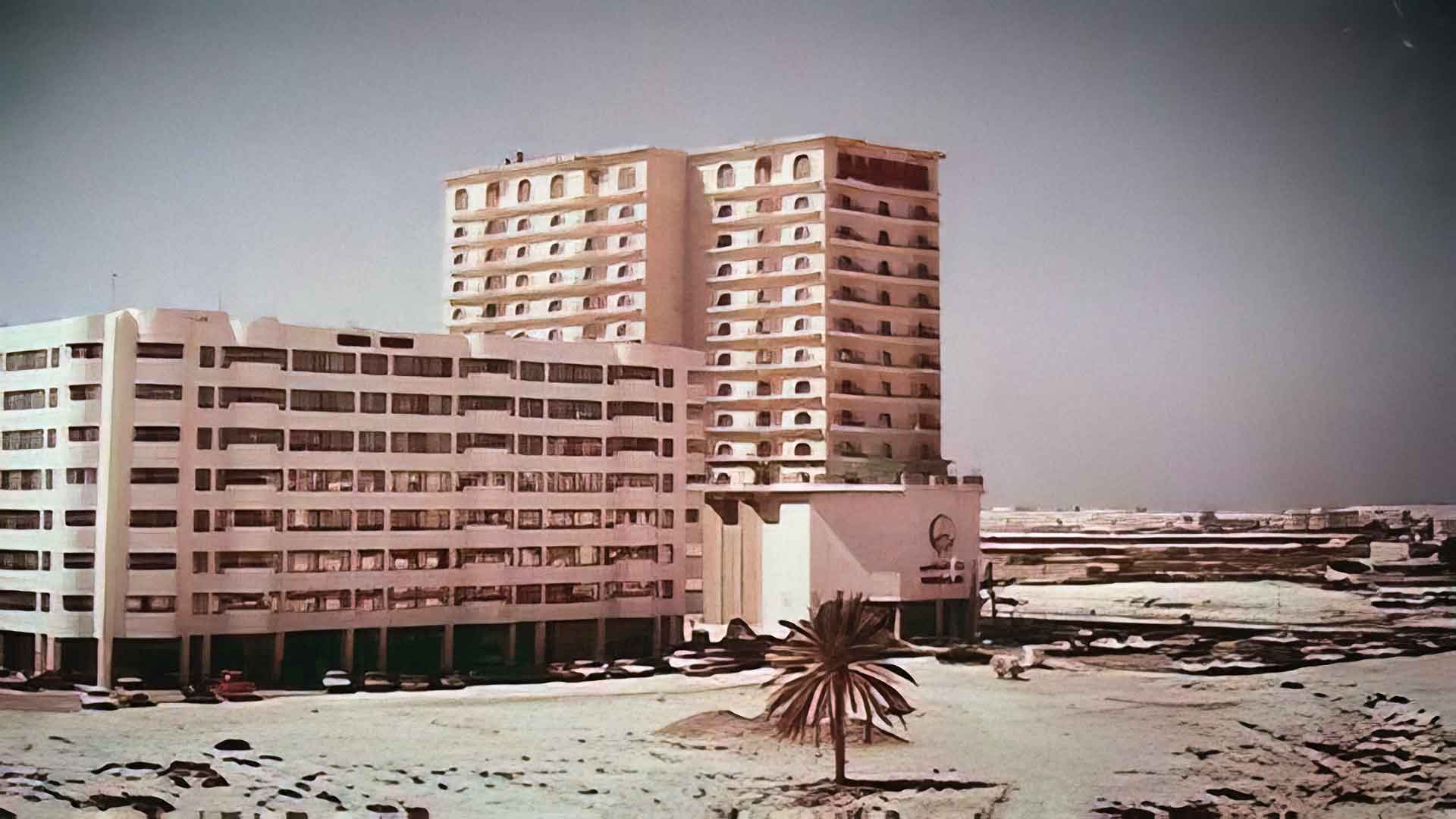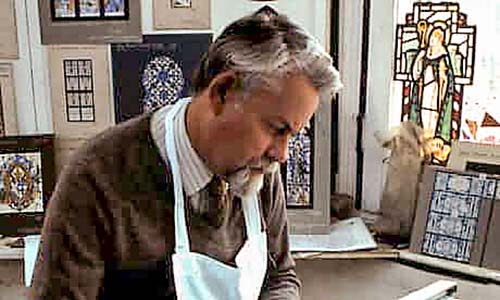
Ramada Hotel was surrounded by desert in 1983
Because of its location, Ramada attracted local clientele
Ramada became the place to go for nearby Residents and those from Satwa and Jumeira
Many of the Hotel's Staff had worked there for 30 years
Demolition of the Ramada Hotel meant the loss of a home and a community centre for many.
Ramada Hotel 1983

Gold has always been Dubai's business.
Gold has rarely been used to decorate Dubai's buildings.
Architects turned to glass to bring glitz to new buildings rising out of Dubai's sand.
One of the first was the Ramada Hotel Dubaiside.
The Ramada Hotel in Dubai had no view to offer, except the desert and some concrete structures around. It therefore had to have a magnificent atrium space with the idea that this atrium would become the central feature.
Since the atrium scaled the entire height of the hotel, we decided to adorn it with an imposing 135-foot high, stained-glass mural. When finished, the spectacular mural covered a width of 28 feet and rose to a height of 135 feet, making it the highest mural in the world, as featured in the Guinness Book of Records.
A British Company, Goddard and Gibbs created the mural. Designed by John Lawson, the Chief Artist of the company, it is based on 17th century Moghul designs. It depicts a floral pattern with birds unobtrusively in the background. The final surface of the glass-fibremouldings was set with rare granites, quartz and crushed coloured stones to form a rich texture complementing the stained glass.
IMK Architects

Ramada Hotel closed in January 2017 and subsequently demolished.
Ramada's unique stained glass mural was to be stored or, maybe installed in another hotel or sold.
2021 - No further news to date!!

John Lawson, who has died of cancer aged 77, was one of the leading stained-glass artists of his generation. He designed glorious windows not only in Westminster Abbey and many other British cathedrals and churches, but also in mosques, palaces and hotels as far afield as Dubai, Oman and Brunei. For the last three decades of the 20th century he was chief artist for the internationally renowned Goddard & Gibbs Studios.
When the 20-year restoration of Westminster Abbey was nearing completion in 1992, Donald Buttress, the Surveyor of the Fabric, or cathedral architect, suggested that the work should be commemorated with a replacement stained-glass window for the plain clear-glass one on the west wall of the abbey's early-16th-century Henry VII chapel. Lawson was called in to create a window that would let in enough light and be "neither overpowering nor anaemic" and, using his knowledge of heraldry, designed the magnificent window that is there today. It was unveiled by the Queen in 1995, and depicts her coat of arms, those of the Duke of Edinburgh and Prince of Wales, and those of Henry VII and his Queen, Elizabeth of York, who are buried in the chapel. Known as the West Window, the Henry VII chapel piece was undoubtedly Lawson's proudest achievement.
However, he was equally known for his art work in the Middle and far east and was much in demand by some of the world's wealthiest rulers and princes. Anyone who has visited the Ramada hotel in Dubai since 1980 will have stood in awe beneath Lawson's stained-glass mural which, at 41 metres high and nine metres wide, was listed in the Guinness Book of Records as the tallest stained-glass structure in the world.
John Lawson designed the glass dome of the Kiarong mosque in Brunei In the early 1990s, impressed by the Englishman's work, the Sultan of Brunei invited Lawson to the capital, Bandar Seri Begawan, to design the glass dome for a new mosque built to commemorate the 25th anniversary of the sultan's reign. Officially named after the sultan, Hassanal Bolkiah, it is better known as the Kiarong mosque and is now a major tourist attraction. As always, Lawson made the original "cartoon", or drawing, at the Goddard & Gibbs studio on Kingsland Road, in Shoreditch, east London. He worked from his own experience and research into Islamic culture and art, but consulted local experts and calligraphers to ensure that the design, including Arabic characters and lettering, met the criteria of Islamic experts.
In Oman, Lawson's windows helped create the unique ambience in the Sultan Qaboos Grand Mosque, which the Sultan has described as "the crowning glory of Oman". The intricate stained-glass windows around the dome filter light that echoes the colours and patterns of the murals and the world's largest single-piece prayer mat. In 2000, Qaboos also commissioned Lawson to design the glass dome above a water feature in the guest complex for his new palace, Beit al-Barakah, outside Muscat. In the late 1980s, Lawson was called in to design the stained-glass dome of an elegant new museum in Bahrain, the Beit al-Qur'an, or House of the Qur'an, which contains a rare collection of ancient holy books.
Closer to home, Lawson's work can be seen in hundreds of churches around Britain, and includes a hanging glass panel depicting Christ the judge in Ripon Cathedral, North Yorkshire, and the windows of the Oratory in Elmore Abbey, the Benedictine monastery in Newbury, Berkshire. Lawson was personally involved in the church for the whole of his life. His funeral was held at Holy Trinity church, near his home in the Hertfordshire village of Leverstock Green, where he had designed the stations of the cross around the walls.
Lawson was born in St Albans, Hertfordshire. His father, William, who died when John was 13, was the managing director of Faith Craft Works in St Albans, a branch of the Church of England's Society of the Faith charity, which designed and crafted stained- glass church windows, including those for the postwar restoration of St Mary-le-Bow in Cheapside, in the City of London.
After attending St Albans school and gaining a diploma in design from the Chelsea School of Art in London, Lawson got his first job in his father's old workshop. In his spare time, John also designed stage sets for the Company of Ten at the Abbey Theatre, St Albans, a leading amateur drama group, where he met a young actress, Frances Baker, whom he married in 1961. In 1971, he was appointed chief artist by Goddard & Gibbs, where he remained until his retirement. He was a member of the Heraldry Society and a fellow of the British Society of Master Glass Painters.
Lawson is survived by Frances, their son, Dominic, and daughters, Rebecca and Helena.
Extract from The Guardian Newspaper
The world's tallest stained glass structure is going to be dismantled when the Ramada Hotel in Bur Dubai is demolished.
No buyer could be found for the 41m high structure that has resided there since the hotel was built in 1983.
"We are going to dismantle the mural and store it in a safe place for future use," said Abdullah Essoni, CEO of Abjar Hotels International, which owns the Ramada franchise in Dubai.
Essoni said the structure did not blend in with any of the current projects, but may eventually be resurrected in a future hotel.
"It's good news that it's not going to be demolished with the rest of the hotel," added Essoni.
"I addressed the press four or five months ago continuously to see if they could find someone interested to salvage it, but nobody came forward to us."
Essoni said he couldnt put a price on the masterpiece's sentimental value. "It's hard to put a value on it really. It's a piece of art," he said.
"If you're just looking at the face value of what it originally cost 30 years ago, it was already in the millions."
He said the deconstruction process, starting in a matter of weeks, will be an agonisingly complex and technical task.
"We've engaged a specialist to do that, it's costing us a bundle to keep it intact," he said.
Essoni lamented the lack of appetite for historic artefacts in the city.
"No one is interested, which is quite surprising actually. I think people have other pre-occupations these days," he said.
No auction will be held for the pillar, designed by the late British stained-glass artist John Lawson.
"I'm just glad we're going to preserve it and I'm sure it will be reinstated in all its glory," he said.